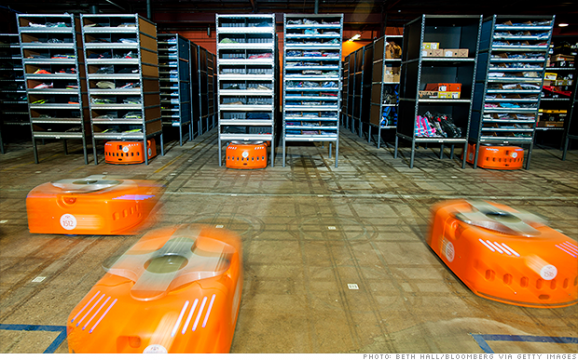Robots To Replace Fast Food Workers And Run Amazon Warehouses
This article is more than 2 years old

As the fight to increase minimum wage rages on, workers from McDonald’s and other fast food chains have protested their low wages, which are too scant to make a living. It would seem that raising the minimum wage would be a sound way to address this problem, but if we’ve learned anything from watching House of Cards, it’s that politicians aren’t terribly interested in the sound and logical. Thus, the obvious plan is to replace these workers with robots.
This ad in the Wall Street Journal last summer warned that increasing the minimum wage would only put people out of work, as employers would have to figure out another way to cut costs—namely, by using automated systems. Robots have been working in restaurants, bars, and hotels for a while now, but they’re still novelties. This may not be the case for long.
Panera Bread recently announced plans to integrate self-service kiosks, as well as mobile ordering within the next three years. Applebee’s and Chili’s have plans to replace waiters with tablets so customers can order and pay without ever seeing the face of wait staff. Does this mean no more leaving tips? Researchers at the University of Oxford put the odds at 92% that the preparation and serving of fast food will be automated in the near future. Some experts think that the changes will happen slowly because of the expectations most of us have when it comes to eating out, but only time will tell. The more people protest their wages, the more likely it is that they’ll be replaced by automatons that never complain about pay.
 By the end of the year, Amazon will have increased the number of robots in its warehouses to 10,000, up from the current 1,000. The droids fulfill orders and ultimately cut down the time and effort it takes to do so. Representatives for the company say that the increase in robots on the warehouse floor won’t result in the laying off of human workers, though if those packages are delivered by drones, they will.
By the end of the year, Amazon will have increased the number of robots in its warehouses to 10,000, up from the current 1,000. The droids fulfill orders and ultimately cut down the time and effort it takes to do so. Representatives for the company say that the increase in robots on the warehouse floor won’t result in the laying off of human workers, though if those packages are delivered by drones, they will.












